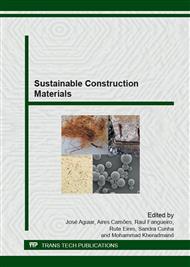[1]
M.C.S. Ribeiro, P.R. Nóvoa, A.J.M. Ferreira, A.T. Marques, Flexural performance of polyester and epoxy polymer mortars under severe thermal conditions, Cement Concrete Comp., 26 (2004) 803-809.
DOI: 10.1016/s0958-9465(03)00162-8
Google Scholar
[2]
C.M.L. Tavares, M.C.S. Ribeiro, A.J.M. Ferreira, R.M. Guedes, Creep behaviour of FRP-reinforced polymer concrete, Compos. Struct., 57 (2002) 47-51.
DOI: 10.1016/s0263-8223(02)00061-2
Google Scholar
[3]
M.C.S. Ribeiro, C.M.C. Pereira, P.R.O. Nóvoa, S.P.B. Sousa, A.J.M. Ferreira, Fire reaction and mechanical performance analyses of polymer concrete materials modified with micro and nano alumina particles, Restoration of Buildings and Monuments, 19 (2013).
DOI: 10.1515/rbm-2013-6595
Google Scholar
[4]
L. Tibiletti, C. Longuet, L. Ferry, P. Coutelen, A. Mas, J. -J. Robin, J. -M. Lopez-Cuesta, Thermal degradation and fire behaviour of unsaturated polyesters filled with metallic oxides, Polym. Degrad. Stabil., 96 (2011) 67-75.
DOI: 10.1016/j.polymdegradstab.2010.10.015
Google Scholar
[5]
C. Katsoulis, E. Kandare, B.K. Kandola, The combined effect of epoxy nanocomposites and phosphorous flame retardant additives on thermal and fire reaction properties of fiber-reinforced composites, J. Fire Sci., 29 (2011) 361-383.
DOI: 10.1177/0734904111398785
Google Scholar
[6]
A.P. Mouritz, A.G. Gibson, Fire Properties of Polymer Composite Materials, Springer, The Netherlands, (2006).
Google Scholar
[7]
A. Laachachi, M. Cochez, E. Leroy, M. Ferriol, J.M. Lopez-Cuesta, Fire retardant systems in poly(methylmathacrylate): Interactions between metal oxide nanoparticles and phosphinates, Polym. Degrad. Stabil., 92 (2007) 61-69.
DOI: 10.1016/j.polymdegradstab.2006.09.011
Google Scholar
[8]
M. Doğan, E. Bayramlı, The flame retardant effect of aluminum phosphinate in combination with zinc borate, borophosphate and nanoclay in polyamide-6, Fire Mater., 38 (2014) 92-99.
DOI: 10.1002/fam.2165
Google Scholar
[9]
S. Bourbigot, F. Samyn, T. Turf, S. Duquesne, Nanomorphology and reaction to fire of polyurethane and polyamide nanocomposites containing flame retardants, Polym. Degrad. Stabil., 95 (2010) 320-326.
DOI: 10.1016/j.polymdegradstab.2009.11.011
Google Scholar
[10]
R. Baskaran, M. Sarojadevi, C. Vijayakumar, Unsaturated polyester nanocomposites filled with nano alumina, J. Mater. Sci., 46 (2011) 4864-4871.
DOI: 10.1007/s10853-011-5398-7
Google Scholar
[11]
G. Ilia, M. Drehe, Grafted 2-chloroethylphosphonic acid on inorganic supports used as flame retardant for unsaturated polyester resins, Fire Mater., 34 (2010) 271-283.
DOI: 10.1002/fam.1022
Google Scholar
[12]
M. Zhang, R.P. Singh, Mechanical reinforcement of unsaturated polyester by AL2O3 nanoparticles Mater. Lett., 58 (2004) 408-412.
DOI: 10.1016/s0167-577x(03)00512-3
Google Scholar
[13]
Y. Du, N. Jain, A. Shukla, Effect of particle size on fracture behavior of polyester/Al2O3 composites, SEM Annual Conference and Exposition on Experimental and Applied Mechanics, St. Louis, Missouri, USA, (2006).
Google Scholar
[14]
D.C. Moreira, L.A. Sphaier, J.M.L. Reis, L.C.S. Nunes, Experimental investigation of heat conduction in polyester–Al2O3 and polyester–CuO nanocomposites, Exp. Therm. Fluid Sci., 35 (2011) 1458-1462.
DOI: 10.1016/j.expthermflusci.2011.06.004
Google Scholar
[15]
D.C. Moreira, L.A. Sphaier, J.M.L. Reis, L.C.S. Nunes, Determination of Young's modulus in polyester-Al2O3 and epoxy-Al2O3 nanocomposites using the Digital Image Correlation method, Compos. Part A-Appl. S., 43 (2012) 304-309.
DOI: 10.1016/j.compositesa.2011.11.005
Google Scholar
[16]
J. Svehla, B. Feichtenschlager, T. Schmidt, D. Holzinger, G. Kickelbick, Sol–gel processing at increased temperatures: the formation of polyester nanocomposites, J. Sol-Gel Sci Techn., 57 (2011) 287-298.
DOI: 10.1007/s10971-010-2207-8
Google Scholar
[17]
Y. Chen, S. Zhou, G. Chen, L. Wu, Preparation and characterization of polyester/silica nanocomposite resins, Prog. Org. Coat., 54 (2005) 120-126.
DOI: 10.1016/j.porgcoat.2004.03.013
Google Scholar
[18]
UL-94, Standard Test for Flammability of Plastic Materials for Parts in Devices and Appliances, Underwriters Laboratories Inc., Norhbrook, IL, USA, (2001).
Google Scholar
[19]
ISO 178: 2001, Plastics - Determination of flexural properties, International Organization for Standardization, Geneva, Switzerland, (2001).
Google Scholar
[20]
ISO 868: 2003, Plastics and Ebonite- Determination of indentation hardness by means of a durometer (Shore hardness), International Organization for Standardization, Geneva, Switzerland, (2003).
DOI: 10.3403/02797078
Google Scholar
[21]
ISO 179: 1982, Plastics - Determination of Charpy impact strength of rigid materials, ISO 179: 1982, International Organization for Standardization, Geneva, Switzerland, (2001).
Google Scholar
[22]
M.J. Anderson, P.J. Whitcomb, Design of Experiments, in: Kirk-Othmer Encyclopedia of Chemical Technology, John Wiley & Sons, Inc., 2000, pp.1-22.
Google Scholar
[23]
K.Z.K. Ahmad, S.H. Ahmad, M.A. Tarawneh, Evaluation of mechanical properties of epoxy/nanoclay/multi-walled carbon nanotube nanocomposites using Taguchi Method, Procedia Chemistry, 4 (2012) 80-86.
DOI: 10.1016/j.proche.2012.06.012
Google Scholar
[24]
R.A. Kishore, R. Tiwari, A. Dvivedi, I. Singh, Taguchi analysis of the residual tensile strength after drilling in glass fiber reinforced epoxy composites, Mater. Design, 30 (2009) 2186-2190.
DOI: 10.1016/j.matdes.2008.08.035
Google Scholar


